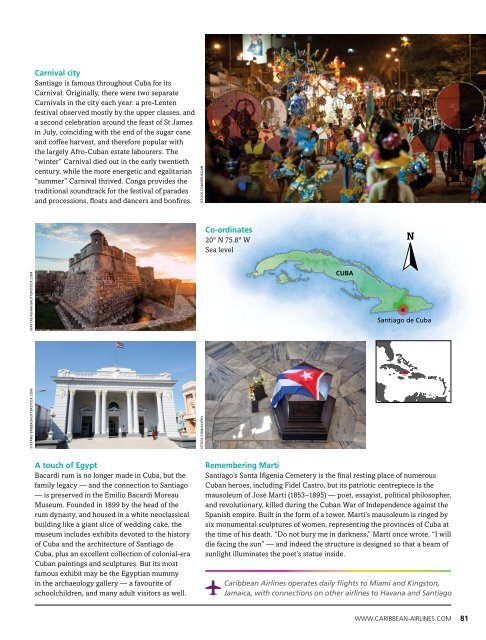Caribbean Beat — July/August 2017 (#146)
A calendar of events; music, film, and book reviews; travel features; people profiles, and much more.
A calendar of events; music, film, and book reviews; travel features; people profiles, and much more.
You also want an ePaper? Increase the reach of your titles
YUMPU automatically turns print PDFs into web optimized ePapers that Google loves.
Matyas Rehak/SHUTTERSTOCK.COM<br />
Stefano Ember/shutterstock.com<br />
Carnival city<br />
Santiago is famous throughout Cuba for its<br />
Carnival. Originally, there were two separate<br />
Carnivals in the city each year: a pre-Lenten<br />
festival observed mostly by the upper classes, and<br />
a second celebration around the feast of St James<br />
in <strong>July</strong>, coinciding with the end of the sugar cane<br />
and coffee harvest, and therefore popular with<br />
the largely Afro-Cuban estate labourers. The<br />
“winter” Carnival died out in the early twentieth<br />
century, while the more energetic and egalitarian<br />
“summer” Carnival thrived. Conga provides the<br />
traditional soundtrack for the festival of parades<br />
and processions, floats and dancers and bonfires.<br />
istock.com/alxpin istock.com/orukojin<br />
Co-ordinates<br />
20º N 75.8º W<br />
Sea level<br />
CUBA<br />
Santiago de Cuba<br />
wilfred dederer<br />
A touch of Egypt<br />
Bacardi rum is no longer made in Cuba, but the<br />
family legacy <strong>—</strong> and the connection to Santiago<br />
<strong>—</strong> is preserved in the Emilio Bacardí Moreau<br />
Museum. Founded in 1899 by the head of the<br />
rum dynasty, and housed in a white neoclassical<br />
building like a giant slice of wedding cake, the<br />
museum includes exhibits devoted to the history<br />
of Cuba and the architecture of Santiago de<br />
Cuba, plus an excellent collection of colonial-era<br />
Cuban paintings and sculptures. But its most<br />
famous exhibit may be the Egyptian mummy<br />
in the archaeology gallery <strong>—</strong> a favourite of<br />
schoolchildren, and many adult visitors as well.<br />
Remembering Martí<br />
Santiago’s Santa Ifigenia Cemetery is the final resting place of numerous<br />
Cuban heroes, including Fidel Castro, but its patriotic centrepiece is the<br />
mausoleum of José Martí (1853–1895) <strong>—</strong> poet, essayist, political philosopher,<br />
and revolutionary, killed during the Cuban War of Independence against the<br />
Spanish empire. Built in the form of a tower, Martí’s mausoleum is ringed by<br />
six monumental sculptures of women, representing the provinces of Cuba at<br />
the time of his death. “Do not bury me in darkness,” Martí once wrote, “I will<br />
die facing the sun” <strong>—</strong> and indeed the structure is designed so that a beam of<br />
sunlight illuminates the poet’s statue inside.<br />
<strong>Caribbean</strong> Airlines operates daily flights to Miami and Kingston,<br />
Jamaica, with connections on other airlines to Havana and Santiago<br />
WWW.CARIBBEAN-AIRLINES.COM 81


















